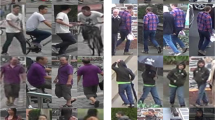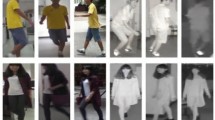Abstract
Great improvement has been made in pedestrian re-identification, but the test results in unknown domain are not satisfactory. This is because the pedestrian Re-ID model does not learn good common features between different domains. We found that view-angle related features are invariant in different domains. Based on this, we develop a cross-domain Re-ID method. Specifically, any pedestrian image is decomposed under the constraints of multiple view angles and the pedestrian multi-view features are generated. We propose an improved lightweight capsule network as the multi-view decomposition. The experimental results showed that our method can effectively improve the cross-domain performance of Re-ID.











Similar content being viewed by others
References
Bak S, Carr P, Lalonde J (2018) Domain adaptation through synthesis for unsupervised person re-identification. In: ECCV2018, pp 193–209
Busto PP, Gall J (2017) Open set domain adaptation. In: ICCV2017, pp 754–763
Chen T, Wang Z, Yang X, Jiang K (2019) A deep capsule neural network with stochastic delta rule for bearing fault diagnosis on raw vibration signals. Measurement 148:106857
Chen W, Chen X, Zhang J, Huang K (2017) Beyond triplet loss: a deep quadruplet network for person re-identification. In: CVPR2017, pp 403–412
Chen P, Dai P, Liu J, Zheng F, Tian Q, Ji R (2020) Dual distribution alignment network for generalizable person re-identification. arXiv:2007.13249
Cheng DS, Cristani M, Stoppa M, Bazzani L, Murino V (2011) Custom pictorial structures for re-identification. In: BMVC2011, pp 68.1–68.11
Chen Y, Zhu X, Gong S (2019) Instance-guided context rendering for cross-domain person re-identification. In: ICCV2019, pp 232–242
Deng W, Zheng L, Ye Q, Kang G, Yang Y, Jiao J (2018) Image-image domain adaptation with preserved self-similarity and domain-dissimilarity for person re-identification. In: CVPR2018, pp 994–1003
Fan H, Zheng L, Yan C, Yang Y (2018) Unsupervised person re-identification: Clustering and fine-tuning. ACM Transactions on Multimedia Computing, Communications, and Applications (TOMM) 14:83
Fang C, Shang Y, Xu D (2018) Improving protein gamma-turn prediction using inception capsule networks. Scientific Reports 8:15741
Farenzena M, Bazzani L, Perina A, Murino V, Cristani M (2010) Person re-identification by symmetry-driven accumulation of local features. In: CVPR2010, pp 2360–2367
Fu Y, Wei Y, Wang G, Zhou Y, Shi H, Uiuc U, Huang TS (2019) Self-similarity grouping: a simple unsupervised cross domain adaptation approach for person re-identification. In: ICCV2019, pp 6112–6121
Gazzaniga M, Ivry RB, Mangun GR (2013) Cognitive neuroscience: the biology of the mind (4th edn). Norton & Company, W. W
Hinton GE, Sabour S, Frosst N (2018) Matrix capsules with EM routing. In: ICLR2018, pp 1–15
Jia J, Ruan Q, Hospedales TM (2019) Frustratingly easy person re-identification: generalizing person Re-ID in practice. In: BMVC2019, pp 1–14
Kodirov E, Xiang T, Fu Z, Gong S (2016) Person re-identification by unsupervised \(\ell\)1 graph learning. In: ECCV2016, pp 178–195
Kodirov E, Xiang T, Gong S (2015) Dictionary learning with iterative laplacian regularisation for unsupervised person re-identification. In: BMVC2015, pp 44.1–44.12
Kosiorek AR, Sabour S, Teh YW, Hinton GE (2019) Stacked capsule autoencoders. In: NeurIPS2019, pp 15486–15496
Liang W, Wang G, Lai J, Zhu J (2018) M2M-GAN: many-to-many generative adversarial transfer learning for person re-identification. arXiv:1811.03768
Lin CS, Cheng YC, Wang YCF (2020) Domain generalized person re-identification via cross-domain episodic learning. In: ICPR2020, pp 6758–6763
Lin S, Li H, Li C-T, Kot AC (2018) Multi-task mid-level feature alignment network for unsupervised cross-dataset person re-identification. In: BMVC2018, pp 9
Long M, Cao Y, Wang J, Jordan MI (2015) Learning transferable features with deep adaptation networks. In: ICML2015, pp 97–105
Luo C, Song C, Zhang Z (2020) Generalizing person re-identification by camera-aware invariance learning and cross-domain mixup, In: ECCV2020, pp 224–241
Ma AJ, Li J, Yuen PC, Li P (2015) Cross-domain person reidentification using domain adaptation ranking svms. IEEE Transactions on Image Processing 24:1599–1613
Peng P, Xiang T, Wang Y, Pontil M, Gong S, Huang T, Tian Y (2016) Unsupervised cross-dataset transfer learning for person re-identification. In: CVPR2016, pp 1306–1315
Qin C, Song S, Huang G, Zhu L (2015) Unsupervised neighborhood component analysis for clustering. Neurocomputing 168:609–617
Rajasegaran J, Jayasundara V, Jayasekara S, Jayasekara H, Seneviratne S, Rodrigo R (2019) DeepCaps: going deeper with capsule networks. In: CVPR2019, pp 10725–10733
Sabour S, Frosst N, Hinton GE (2017) Dynamic routing between capsules. In: NIPS2017, pp 3856–3866
Sadreazami H, Bolic M, Rajan S (2019) CapsFall: fall detection using ultra-wideband radar and capsule network. IEEE Access 7:55336–55343
Saito K, Yamamoto S, Ushiku Y, Harada T (2018) Open set domain adaptation by backpropagation. In: ECCV2018, pp 156–171
Song J, Yang Y, Song YZ, Xiang T, Hospedales TM (2019) Generalizable person re-identification by domain-invariant mapping network. In: CVPR2019, pp 719–728
Su C, Zhang S, Xing J, Gao W, Tian Q (2016) Deep attributes driven multi-camera person re-identification. In: ECCV2016, pp 475–491
Tamura M, Yoshinaga T (2020) BCaR: Beginner classifier as regularization towards generalizable re-ID. In: BMVC2020, pp 1–12
Wang H, Gong S, Xiang T (2014) Unsupervised learning of generative topic saliency for person re-identification. In: BMVC2014, pp 1-11
Wang J, Zhu X, Gong S, Li W (2018) Transferable joint attribute-identity deep learning for unsupervised person re-identification. In: CVPR2018, pp 2275–2284
Wei L, Zhang S, Gao W, Tian Q (2018) Person transfer GAN to bridge domain gap for person re-identification. In: CVPR2018, pp 79–88
Xi E, Bing S, Jin Y (2017) Capsule network performance on complex data. arXiv:1712.03480
Yang M, Zhao W, Chen L, Qu Q, Zhao Z, Shen Y (2019) Investigating the transferring capability of capsule networks for text classification. Neural Networks 118(2019):247–261
Yang M, Zhao W, Ye J, Lei Z, Zhao Z, Zhang S (2018) Investigating capsule networks with dynamic routing for text classification. In: EMNLP2018, pp 3110–3119
Ye J, Zhao Z, Liu H (2007) Adaptive distance metric learning for clustering. In: CVPR2007, pp 1–7
Yin H, Liu P, Zhu Z, Li W, Wang Q (2019) Capsule network with identifying transferable knowledge for cross-domain sentiment classification. IEEE Access 7:153171–153182
Yu H-X, Wu A, Zheng W-S (2017) Cross-view asymmetric metric learning for unsupervised person re-identification. In: ICCV2017, pp 994–1002
Zhai Y, Lu S, Ye Q, Shan X, Chen J, Ji R, Tian Y (2020) AD-Cluster: augmented discriminative clustering for domain adaptive person re-identification. In: CVPR2020, pp 9021–9030
Zhang B, Xu X, Yang M, Chen X, Ye Y (2018) Cross-domain sentiment classification by capsule network with semantic rules. IEEE Access 6:58284–58294
Zhang X, Cao J, Shen C, You M (2019) Self-training with progressive augmentation for unsupervised cross-domain person re-identification. In: ICCV2019, pp 8222–8231
Zhang S, Zhou Q, Wu X (2018) Fast dynamic routing based on weighted kernel density estimation. In: ISAIR2018, pp 301–309
Zhao R, Oyang W, Wang X (2017) Person re-identification by saliency learning. IEEE Transactions on Pattern Analysis and Machine Intelligence 39:356–370
Zheng L, Shen L, Tian L, Wang S, Wang J, Tian Q (2015) Scalable person re-identification: a benchmark. In: ICCV2015, pp 1116–1124
Zhong Z, Zheng L, Li S, Yang Y (2018) Generalizing a person retrieval model hetero-and homogeneously. In: ECCV2018, pp 176–192
Acknowledgements
We would like to thank Edmund F. and Rhoda E. Perozzi for extensive professional language and content editing. This work is partially supported by research grants from the National Natural Science Foundation of China(61873178, 61976150), Natural Science Foundation of Shanxi Province (201901D111091), Key Research And Development Projects of Shanxi Province(201803D31038), Key Research And Development Projects of Jinzhong City(Y192006), CERNET Next Generation Internet Technology Innovation Project(NGII20181206), Domestic and Foreign Crop Yield Meteorology Forecast Special Project(RH19100004).
Author information
Authors and Affiliations
Corresponding author
Additional information
Publisher’s note
Springer Nature remains neutral with regard to jurisdictional claims in published maps and institutional affiliations.
Rights and permissions
About this article
Cite this article
Yang, X., Zhou, Z., Wang, Q. et al. Cross-domain unsupervised pedestrian re-identification based on multi-view decomposition. Multimed Tools Appl 81, 39387–39408 (2022). https://doi.org/10.1007/s11042-021-11797-w
Received:
Revised:
Accepted:
Published:
Issue Date:
DOI: https://doi.org/10.1007/s11042-021-11797-w




